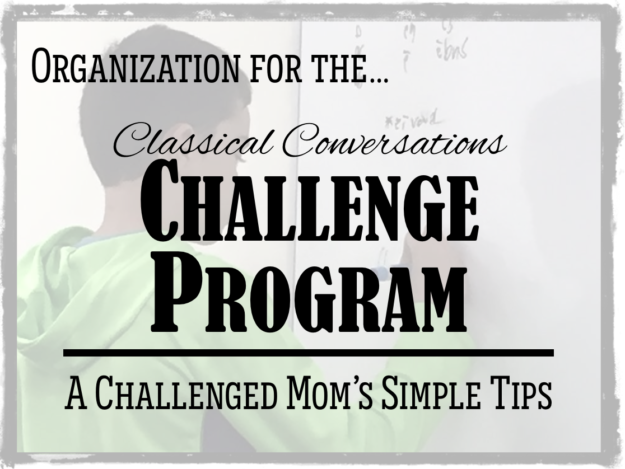
I’m always hesitant to share my thoughts on the Classical Conversations Challenge Program because I want parents’ first source to be their child’s Challenge tutor. Nevertheless, in case this is helpful to other Challenge parents, here are a few things that have kept us organized and moving forward over the past couple of years. Just remember that your director is trained to help you make the most of the Challenge program, so be sure to see them first when you need advice or assistance with anything Challenge-related! (Challenge directors rock!)
And… if you’re completely new to Challenge, you might just save this back and come back to it after you’ve gotten into the semester a few weeks. (It was honestly easier for me to just walk into Challenge A for the first time without trying to overplan or overthink it.)
The Plan-Your-Week Meeting. After we get back from our community day, I meet with our Challenge student to plan his week. Although we are both usually pretty tired after community day, it has proven worthwhile to meet for 30 minutes (sometimes less!) to discuss and organize the coming week’s work before bedtime. When we wait until the next morning, it takes a much longer period of time and throws the day off by at least one hour. For us, it’s just worth being diligent about doing this on community day. I also don’t throw a complicated planner at my son, but just provide him with a simple single planner page for each week for him to jot down his assignments.
Organize with Post-it Tabs. The Challenge Guide is pretty simple to organize. We use 6 index dividers with pockets to divide each seminar’s information (in the appendix). Behind these dividers, we also include anything that a tutor gives the student in class (or anything we print at home). For the weekly lessons, we place a single sturdy post-it-note tab on the current week and move it through the weeks as our year progresses. In the Challenge Guide, we’ve only used one post-it tab, but we now use post-it tabs as bookmarks for everything. (And it’s also how I’ve organized our Foundations Guide. Post-it Tabs are my favorite.)
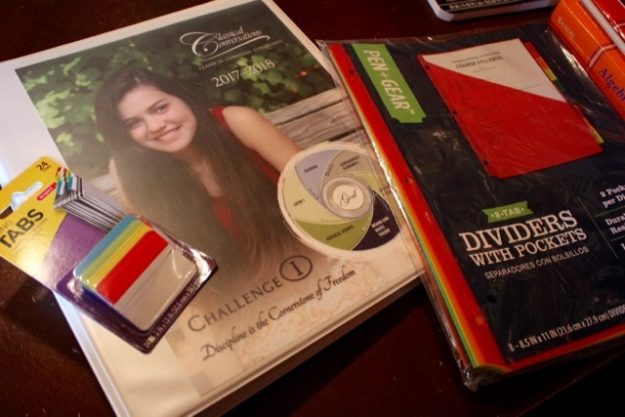
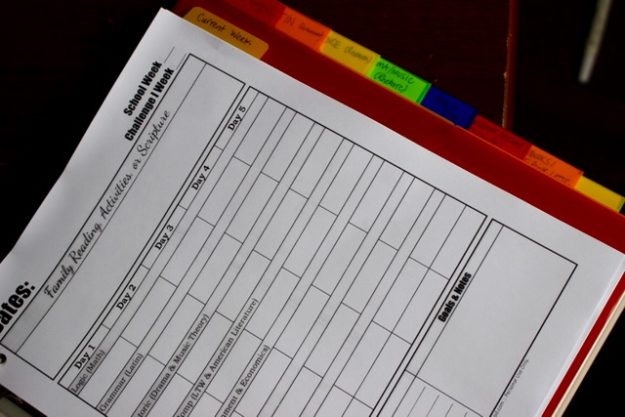
The planner page shown above may be downloaded as the second option here. I print out 15 of these per semester; he fills one out each week after we get home on seminar day to plan for the coming week.
We also organize our Latin book with Post-It tabs. In the picture below, Stephen has tabbed the lesson numbers on the right and the unit numbers at the top. Inside our Henle book, we’ve highlighted in blue all the new vocabulary as it is introduced. I did this for myself last year, and Stephen thanked me this year as he was returning to the beginning of the book to start all over again in Challenge I.
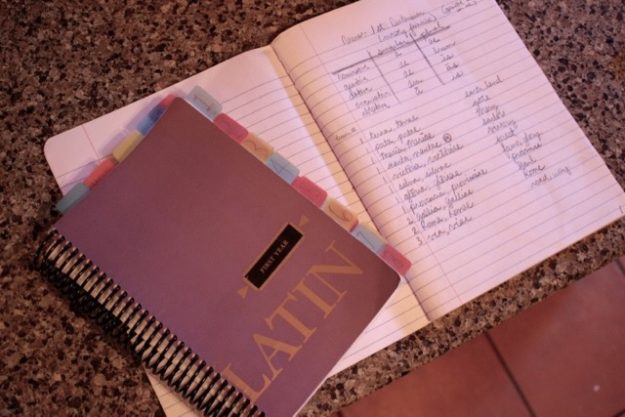
Composition Books. We use a composition book for almost every strand. For us, it’s easier than keeping up with individual notebook pages in a great-big-ole-gargantuan binder, and composition books can handle the wear and tear of a teenage boy better than a spiral notebook can. You can use the bullet-journal method for organizing what’s inside by numbering the pages and using the first two pages as an Index to list the page numbers for anything you may want to later look up. (The bullet-journal-indexing method is shown in the photo below. You’ll have to number the pages in your composition book, but I think it’s worth it to be able to find stuff later!)
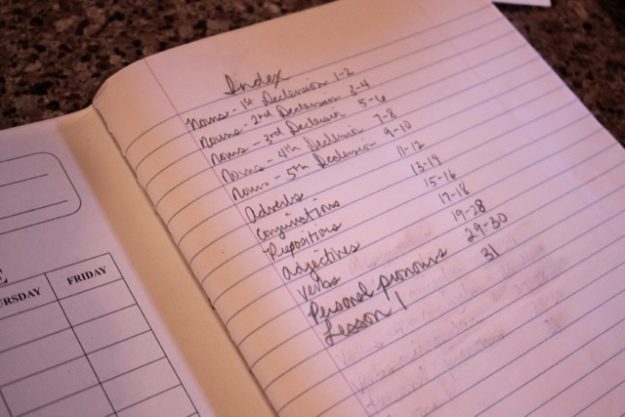
Latin. That leads us into Latin. Okay, fellow parents. It’s time for another episode of “Confessions of a Homeschool Mama.” Errr….. I didn’t really keep up with Latin studies. Yep, I’m starting to feel it now that we’re entering Challenge 1. (I regret not keeping up with vocabulary and grammar in Challenge A and B, mainly because the entire Henle 1 Latin book is really quite intimidating for me at this point.) Because managing an enormous number of flashcards gives me heart palpitations, I’m instead keeping a log of all vocabulary to memorize as our oldest son races through Henle 1 this year. He asked if – instead of making a new set of cards this year as I had him do in Challenge B – he can also keep a log of the vocabulary as I’m doing. Funny thing is, it’s already a much easier way for me (and him) to study vocabulary. Here’s what it looks like:
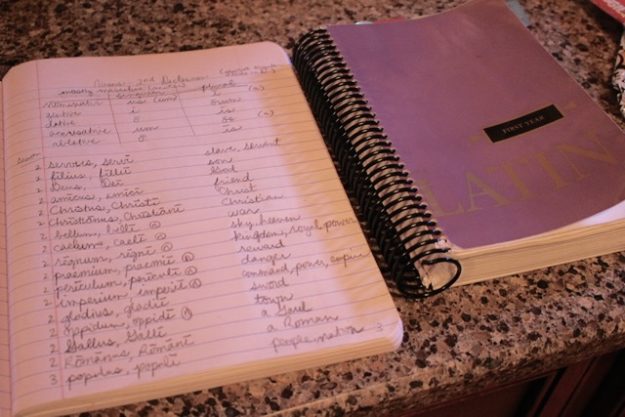
On the first 30 pages or so of my Latin notebook, I’ve organized pages with headings for the different parts of speech, and then I’ve listed those on the first page in my “index.”

The Latin Parts of Speech pages are currently…
- Nouns – 1st Declension
- Nouns – 2nd Declension
- Nouns – 3rd Declension
- Nouns – 4th Declension
- Nouns – 5th Declension
- Adverbs
- Conjunctions
- Prepositions
- Adjectives
- Verbs (Later I may make new lists organized by conjugation, but for now I just want to list the verbs as I work through the text. For now, I’ve left a lot of pages open for verbs.)
- Pronouns (Labeled as Personal Pronouns, but I’ve changed this so I can log all pronouns as I come across them in the Henle book)
(I’ve set aside at least two pages for each part of speech or declension.) Now that I’ve logged all the vocabulary from Lessons 1-6, I can drill the vocabulary by covering up one side and quizzing myself on the English or Latin counterpart. (I’ve also included whether a noun is feminine or masculine if it goes against the normal gender for that declension.)
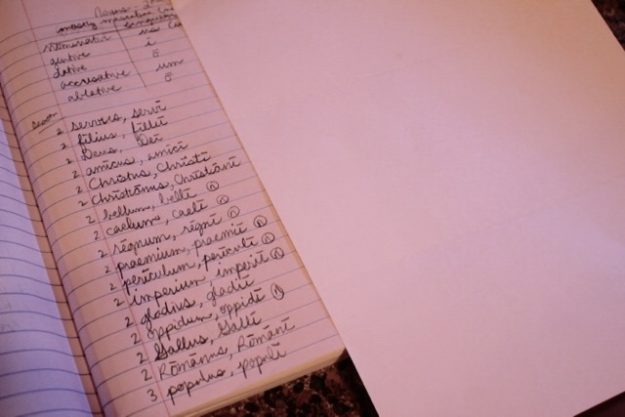
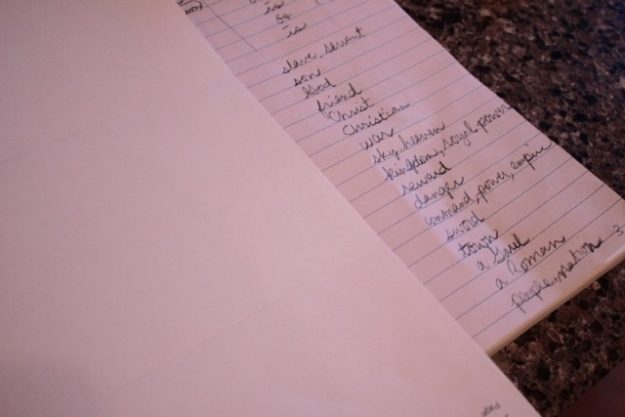
I still find value in flashcards, but this will help me significantly as I play catch up this year. Quizlet is also a great study tool!
Scale assignments. Although we’ve never dropped a seminar, we’ve held back the pace or adjusted assignments at times according to our family’s needs and circumstances. For example, in Challenge A, our Challenge student did not keep up with the geography term flashcards but instead used other resources such as the Exploring Water & Land Forms Pin-It Map. (The regular Pin-It Maps are also great for countries & capitals practice, although Stephen primarily used our Capitals & Countries Flashcards to memorize capitals. Other options include Quizlet geography terms and Quizlet geography countries/capitals.) In Challenge B, he read all of the short stories and completed the respective assignments, but the construction of his short story was delayed by a few weeks. In just one afternoon, however, he was able to apply all that he had learned up to that point to come up with the structure, characters, plot, etc. for his story. Sometimes doing a job well means you have to do fewer things . That doesn’t mean we drop a strand altogether just because we find the work hard. (After all, man has had an aversion to work since the fall in the garden; it’s part of our nature that we must and can overcome – think Philippians 4:13.) Although students need to be prepared for all seminars, they can be prepared for seminar at their level. That means sometimes we complete fewer tasks within a seminar. It’s part of honoring the student and meeting the student where s/he is. That might mean a different pace for Latin, a different text for math, a different number of LTW essays. Adjust it in a way that makes sense for your family instead of giving up on everything.
Science Fair (for Challenge B’ers). At the beginning of the school year, brainstorm everything your child is interested in, and write it all down in a notebook to explore ideas together throughout the semester. If I could turn back time, I would have had our son do this at the beginning of the year to find a science research project that truly interested him rather than just selecting something – anything – just because it was simple and measurable. Stephen immensely disliked science fair because, although the topic was simple, he was not at all interested in it. I have come across some students who have absolutely loved science fair. In the end, I think it’s a matter of interest in the topic. So… try to exhaust all experiment ideas that align with their genuine interests before just giving up and looking on the Science Buddies website. Remind your child s/he doesn’t have to do anything new or different or Einstein-ish – they’re learning the scientific method and how to present their findings. Encourage them to choose a simple project (but still one they truly want to do).
Engage in discussion. Don’t forget to seize the opportunity to engage in discussions with your teenager. This is such a beautiful part of the Challenge program! Remember the Challenge tutor only has your child for 30 days per year. Your child is with you the other 150 days of the school year. By being plugged in, you not only model mentorship, but you also show them their education is important to you. Does that mean you have to keep up with every book they’ve read? No, it doesn’t (although I admit it would be great if I could!). But we can brainstorm with them as they work on the ANI charts and offer food for thought when it comes to Current Events or other topics. When I don’t have the time to read all the books on the Challenge booklist, I use the Plot Diagram (from Teaching the Classics) for my student to give me a Cliffs-Notes synopsis of the book. It helps him to organize his thoughts as he narrates the entire book back to me. It’s a great warm-up to invention week! (Use code REF6CA9VNCSMT to receive 15% off your first order of $100 at Center for Lit.)
Well, I’m afraid I’ve exhausted my thoughts at this point! Do you have questions about the Challenge program? Do you have other thoughts or advice you would offer to parents who are coming into Challenge for the first time? We’d love to read your thoughts in the comments!
